Limitations of International Regulation
VerifiedAdded on 2022/09/09
|9
|2636
|61
AI Summary
Contribute Materials
Your contribution can guide someone’s learning journey. Share your
documents today.
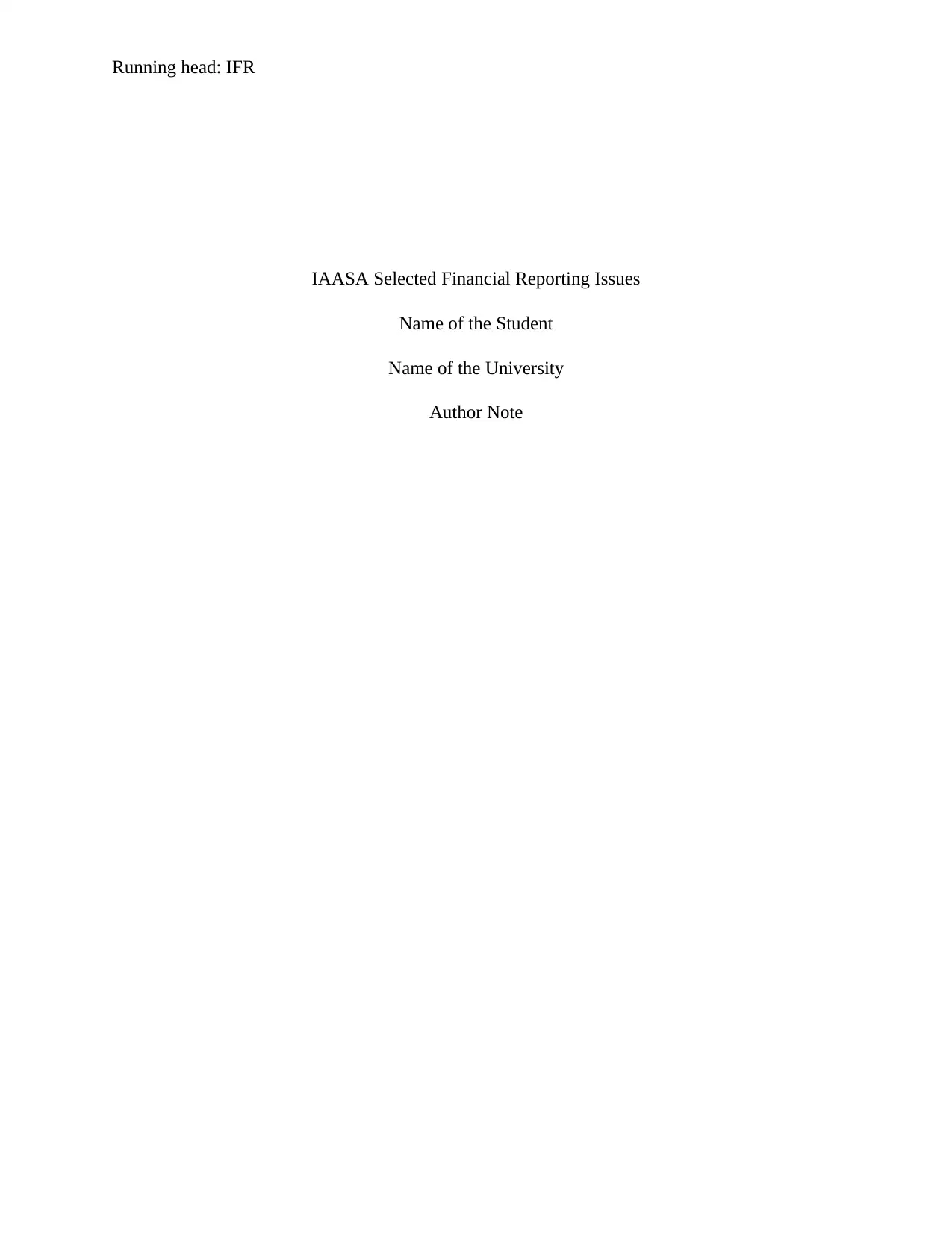
Running head: IFR
IAASA Selected Financial Reporting Issues
Name of the Student
Name of the University
Author Note
IAASA Selected Financial Reporting Issues
Name of the Student
Name of the University
Author Note
Secure Best Marks with AI Grader
Need help grading? Try our AI Grader for instant feedback on your assignments.
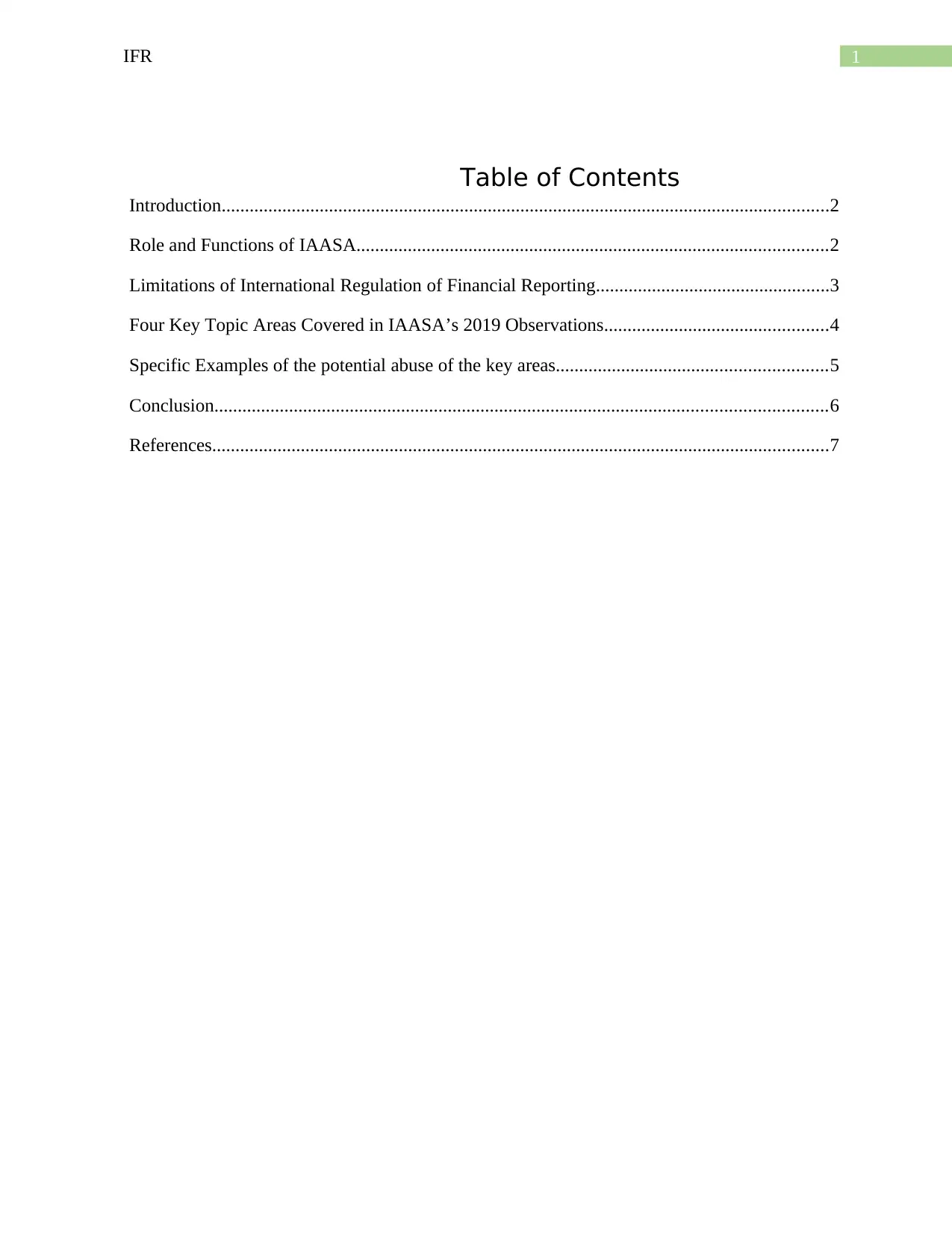
1IFR
Table of Contents
Introduction..................................................................................................................................2
Role and Functions of IAASA.....................................................................................................2
Limitations of International Regulation of Financial Reporting..................................................3
Four Key Topic Areas Covered in IAASA’s 2019 Observations................................................4
Specific Examples of the potential abuse of the key areas..........................................................5
Conclusion...................................................................................................................................6
References....................................................................................................................................7
Table of Contents
Introduction..................................................................................................................................2
Role and Functions of IAASA.....................................................................................................2
Limitations of International Regulation of Financial Reporting..................................................3
Four Key Topic Areas Covered in IAASA’s 2019 Observations................................................4
Specific Examples of the potential abuse of the key areas..........................................................5
Conclusion...................................................................................................................................6
References....................................................................................................................................7
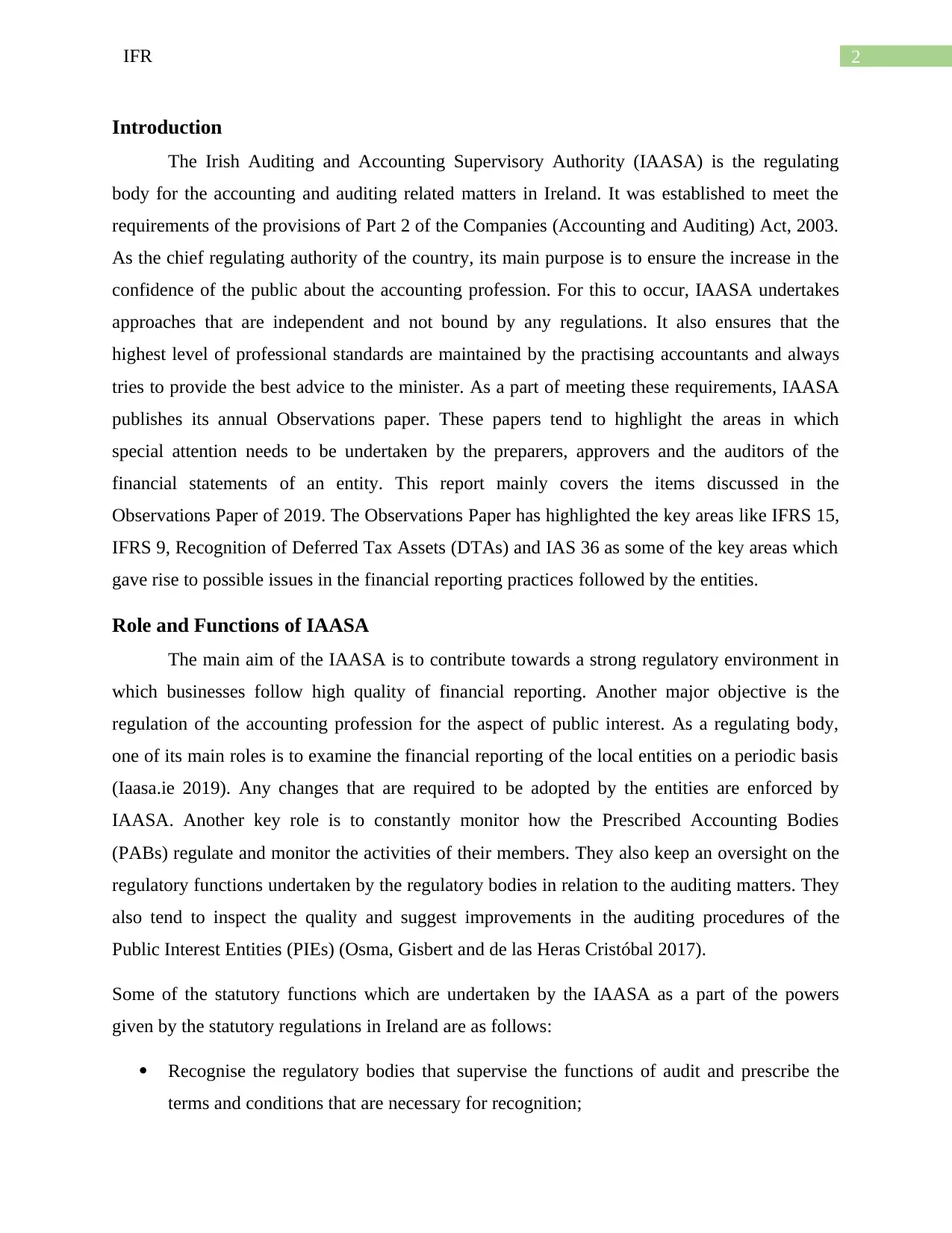
2IFR
Introduction
The Irish Auditing and Accounting Supervisory Authority (IAASA) is the regulating
body for the accounting and auditing related matters in Ireland. It was established to meet the
requirements of the provisions of Part 2 of the Companies (Accounting and Auditing) Act, 2003.
As the chief regulating authority of the country, its main purpose is to ensure the increase in the
confidence of the public about the accounting profession. For this to occur, IAASA undertakes
approaches that are independent and not bound by any regulations. It also ensures that the
highest level of professional standards are maintained by the practising accountants and always
tries to provide the best advice to the minister. As a part of meeting these requirements, IAASA
publishes its annual Observations paper. These papers tend to highlight the areas in which
special attention needs to be undertaken by the preparers, approvers and the auditors of the
financial statements of an entity. This report mainly covers the items discussed in the
Observations Paper of 2019. The Observations Paper has highlighted the key areas like IFRS 15,
IFRS 9, Recognition of Deferred Tax Assets (DTAs) and IAS 36 as some of the key areas which
gave rise to possible issues in the financial reporting practices followed by the entities.
Role and Functions of IAASA
The main aim of the IAASA is to contribute towards a strong regulatory environment in
which businesses follow high quality of financial reporting. Another major objective is the
regulation of the accounting profession for the aspect of public interest. As a regulating body,
one of its main roles is to examine the financial reporting of the local entities on a periodic basis
(Iaasa.ie 2019). Any changes that are required to be adopted by the entities are enforced by
IAASA. Another key role is to constantly monitor how the Prescribed Accounting Bodies
(PABs) regulate and monitor the activities of their members. They also keep an oversight on the
regulatory functions undertaken by the regulatory bodies in relation to the auditing matters. They
also tend to inspect the quality and suggest improvements in the auditing procedures of the
Public Interest Entities (PIEs) (Osma, Gisbert and de las Heras Cristóbal 2017).
Some of the statutory functions which are undertaken by the IAASA as a part of the powers
given by the statutory regulations in Ireland are as follows:
Recognise the regulatory bodies that supervise the functions of audit and prescribe the
terms and conditions that are necessary for recognition;
Introduction
The Irish Auditing and Accounting Supervisory Authority (IAASA) is the regulating
body for the accounting and auditing related matters in Ireland. It was established to meet the
requirements of the provisions of Part 2 of the Companies (Accounting and Auditing) Act, 2003.
As the chief regulating authority of the country, its main purpose is to ensure the increase in the
confidence of the public about the accounting profession. For this to occur, IAASA undertakes
approaches that are independent and not bound by any regulations. It also ensures that the
highest level of professional standards are maintained by the practising accountants and always
tries to provide the best advice to the minister. As a part of meeting these requirements, IAASA
publishes its annual Observations paper. These papers tend to highlight the areas in which
special attention needs to be undertaken by the preparers, approvers and the auditors of the
financial statements of an entity. This report mainly covers the items discussed in the
Observations Paper of 2019. The Observations Paper has highlighted the key areas like IFRS 15,
IFRS 9, Recognition of Deferred Tax Assets (DTAs) and IAS 36 as some of the key areas which
gave rise to possible issues in the financial reporting practices followed by the entities.
Role and Functions of IAASA
The main aim of the IAASA is to contribute towards a strong regulatory environment in
which businesses follow high quality of financial reporting. Another major objective is the
regulation of the accounting profession for the aspect of public interest. As a regulating body,
one of its main roles is to examine the financial reporting of the local entities on a periodic basis
(Iaasa.ie 2019). Any changes that are required to be adopted by the entities are enforced by
IAASA. Another key role is to constantly monitor how the Prescribed Accounting Bodies
(PABs) regulate and monitor the activities of their members. They also keep an oversight on the
regulatory functions undertaken by the regulatory bodies in relation to the auditing matters. They
also tend to inspect the quality and suggest improvements in the auditing procedures of the
Public Interest Entities (PIEs) (Osma, Gisbert and de las Heras Cristóbal 2017).
Some of the statutory functions which are undertaken by the IAASA as a part of the powers
given by the statutory regulations in Ireland are as follows:
Recognise the regulatory bodies that supervise the functions of audit and prescribe the
terms and conditions that are necessary for recognition;
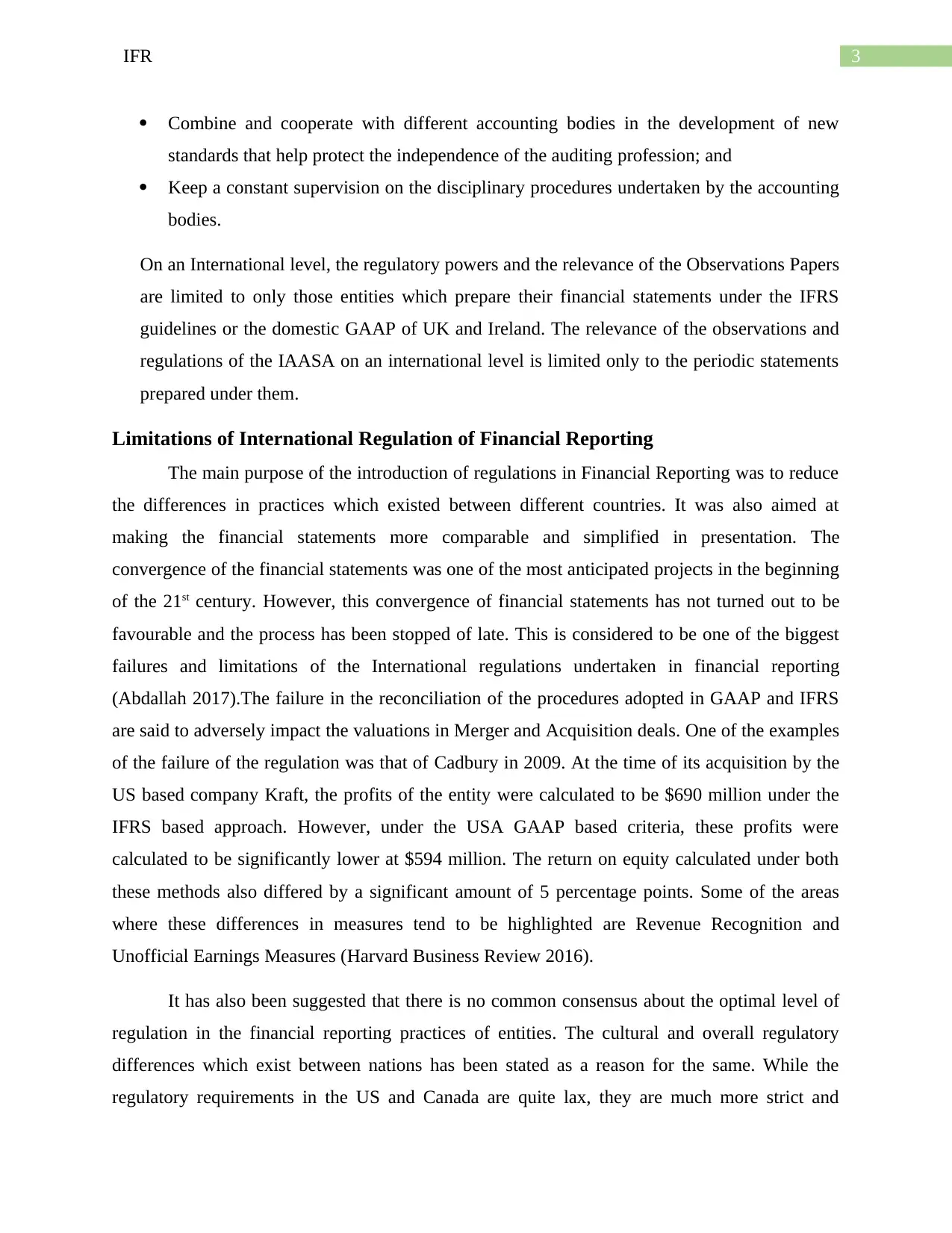
3IFR
Combine and cooperate with different accounting bodies in the development of new
standards that help protect the independence of the auditing profession; and
Keep a constant supervision on the disciplinary procedures undertaken by the accounting
bodies.
On an International level, the regulatory powers and the relevance of the Observations Papers
are limited to only those entities which prepare their financial statements under the IFRS
guidelines or the domestic GAAP of UK and Ireland. The relevance of the observations and
regulations of the IAASA on an international level is limited only to the periodic statements
prepared under them.
Limitations of International Regulation of Financial Reporting
The main purpose of the introduction of regulations in Financial Reporting was to reduce
the differences in practices which existed between different countries. It was also aimed at
making the financial statements more comparable and simplified in presentation. The
convergence of the financial statements was one of the most anticipated projects in the beginning
of the 21st century. However, this convergence of financial statements has not turned out to be
favourable and the process has been stopped of late. This is considered to be one of the biggest
failures and limitations of the International regulations undertaken in financial reporting
(Abdallah 2017).The failure in the reconciliation of the procedures adopted in GAAP and IFRS
are said to adversely impact the valuations in Merger and Acquisition deals. One of the examples
of the failure of the regulation was that of Cadbury in 2009. At the time of its acquisition by the
US based company Kraft, the profits of the entity were calculated to be $690 million under the
IFRS based approach. However, under the USA GAAP based criteria, these profits were
calculated to be significantly lower at $594 million. The return on equity calculated under both
these methods also differed by a significant amount of 5 percentage points. Some of the areas
where these differences in measures tend to be highlighted are Revenue Recognition and
Unofficial Earnings Measures (Harvard Business Review 2016).
It has also been suggested that there is no common consensus about the optimal level of
regulation in the financial reporting practices of entities. The cultural and overall regulatory
differences which exist between nations has been stated as a reason for the same. While the
regulatory requirements in the US and Canada are quite lax, they are much more strict and
Combine and cooperate with different accounting bodies in the development of new
standards that help protect the independence of the auditing profession; and
Keep a constant supervision on the disciplinary procedures undertaken by the accounting
bodies.
On an International level, the regulatory powers and the relevance of the Observations Papers
are limited to only those entities which prepare their financial statements under the IFRS
guidelines or the domestic GAAP of UK and Ireland. The relevance of the observations and
regulations of the IAASA on an international level is limited only to the periodic statements
prepared under them.
Limitations of International Regulation of Financial Reporting
The main purpose of the introduction of regulations in Financial Reporting was to reduce
the differences in practices which existed between different countries. It was also aimed at
making the financial statements more comparable and simplified in presentation. The
convergence of the financial statements was one of the most anticipated projects in the beginning
of the 21st century. However, this convergence of financial statements has not turned out to be
favourable and the process has been stopped of late. This is considered to be one of the biggest
failures and limitations of the International regulations undertaken in financial reporting
(Abdallah 2017).The failure in the reconciliation of the procedures adopted in GAAP and IFRS
are said to adversely impact the valuations in Merger and Acquisition deals. One of the examples
of the failure of the regulation was that of Cadbury in 2009. At the time of its acquisition by the
US based company Kraft, the profits of the entity were calculated to be $690 million under the
IFRS based approach. However, under the USA GAAP based criteria, these profits were
calculated to be significantly lower at $594 million. The return on equity calculated under both
these methods also differed by a significant amount of 5 percentage points. Some of the areas
where these differences in measures tend to be highlighted are Revenue Recognition and
Unofficial Earnings Measures (Harvard Business Review 2016).
It has also been suggested that there is no common consensus about the optimal level of
regulation in the financial reporting practices of entities. The cultural and overall regulatory
differences which exist between nations has been stated as a reason for the same. While the
regulatory requirements in the US and Canada are quite lax, they are much more strict and
Secure Best Marks with AI Grader
Need help grading? Try our AI Grader for instant feedback on your assignments.
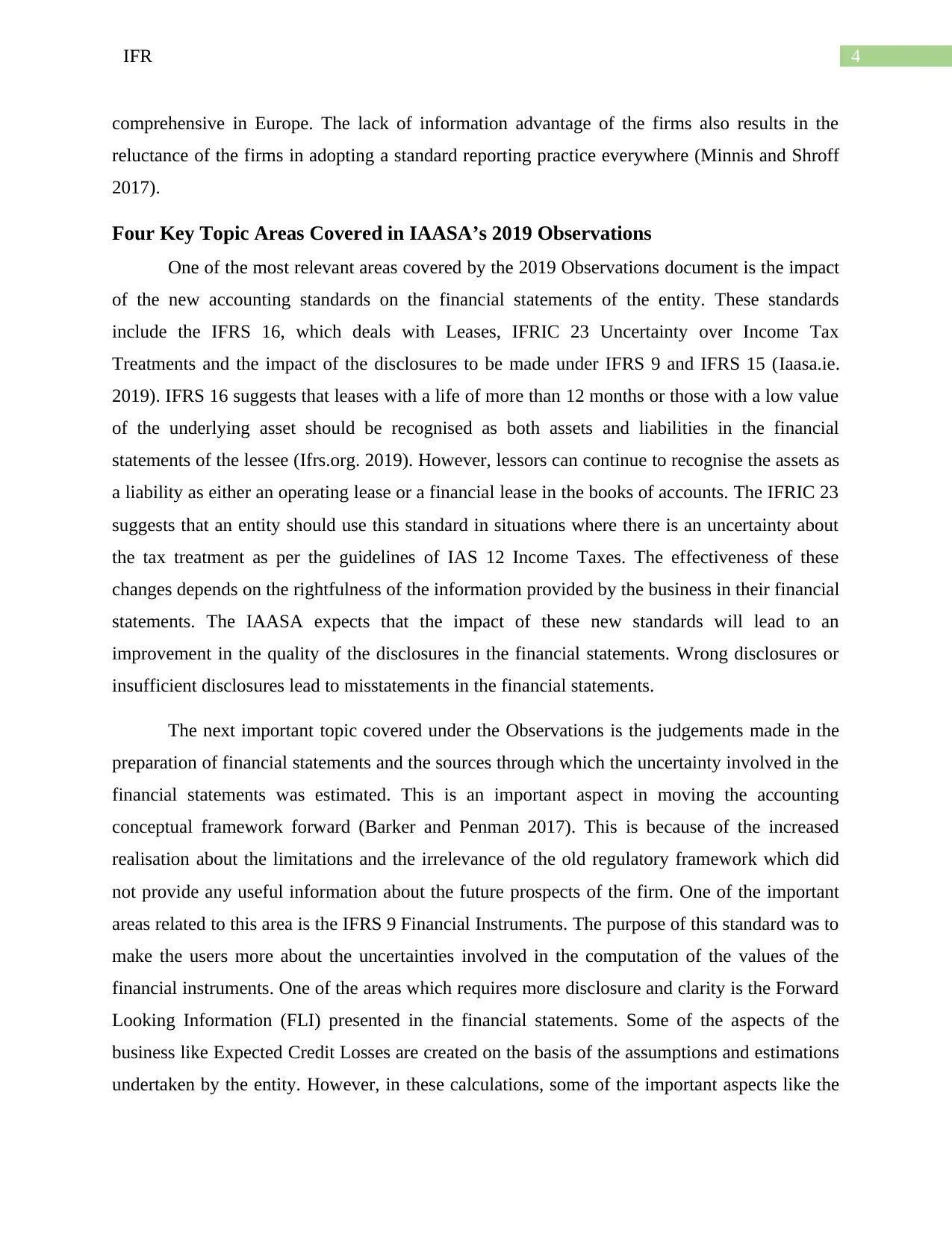
4IFR
comprehensive in Europe. The lack of information advantage of the firms also results in the
reluctance of the firms in adopting a standard reporting practice everywhere (Minnis and Shroff
2017).
Four Key Topic Areas Covered in IAASA’s 2019 Observations
One of the most relevant areas covered by the 2019 Observations document is the impact
of the new accounting standards on the financial statements of the entity. These standards
include the IFRS 16, which deals with Leases, IFRIC 23 Uncertainty over Income Tax
Treatments and the impact of the disclosures to be made under IFRS 9 and IFRS 15 (Iaasa.ie.
2019). IFRS 16 suggests that leases with a life of more than 12 months or those with a low value
of the underlying asset should be recognised as both assets and liabilities in the financial
statements of the lessee (Ifrs.org. 2019). However, lessors can continue to recognise the assets as
a liability as either an operating lease or a financial lease in the books of accounts. The IFRIC 23
suggests that an entity should use this standard in situations where there is an uncertainty about
the tax treatment as per the guidelines of IAS 12 Income Taxes. The effectiveness of these
changes depends on the rightfulness of the information provided by the business in their financial
statements. The IAASA expects that the impact of these new standards will lead to an
improvement in the quality of the disclosures in the financial statements. Wrong disclosures or
insufficient disclosures lead to misstatements in the financial statements.
The next important topic covered under the Observations is the judgements made in the
preparation of financial statements and the sources through which the uncertainty involved in the
financial statements was estimated. This is an important aspect in moving the accounting
conceptual framework forward (Barker and Penman 2017). This is because of the increased
realisation about the limitations and the irrelevance of the old regulatory framework which did
not provide any useful information about the future prospects of the firm. One of the important
areas related to this area is the IFRS 9 Financial Instruments. The purpose of this standard was to
make the users more about the uncertainties involved in the computation of the values of the
financial instruments. One of the areas which requires more disclosure and clarity is the Forward
Looking Information (FLI) presented in the financial statements. Some of the aspects of the
business like Expected Credit Losses are created on the basis of the assumptions and estimations
undertaken by the entity. However, in these calculations, some of the important aspects like the
comprehensive in Europe. The lack of information advantage of the firms also results in the
reluctance of the firms in adopting a standard reporting practice everywhere (Minnis and Shroff
2017).
Four Key Topic Areas Covered in IAASA’s 2019 Observations
One of the most relevant areas covered by the 2019 Observations document is the impact
of the new accounting standards on the financial statements of the entity. These standards
include the IFRS 16, which deals with Leases, IFRIC 23 Uncertainty over Income Tax
Treatments and the impact of the disclosures to be made under IFRS 9 and IFRS 15 (Iaasa.ie.
2019). IFRS 16 suggests that leases with a life of more than 12 months or those with a low value
of the underlying asset should be recognised as both assets and liabilities in the financial
statements of the lessee (Ifrs.org. 2019). However, lessors can continue to recognise the assets as
a liability as either an operating lease or a financial lease in the books of accounts. The IFRIC 23
suggests that an entity should use this standard in situations where there is an uncertainty about
the tax treatment as per the guidelines of IAS 12 Income Taxes. The effectiveness of these
changes depends on the rightfulness of the information provided by the business in their financial
statements. The IAASA expects that the impact of these new standards will lead to an
improvement in the quality of the disclosures in the financial statements. Wrong disclosures or
insufficient disclosures lead to misstatements in the financial statements.
The next important topic covered under the Observations is the judgements made in the
preparation of financial statements and the sources through which the uncertainty involved in the
financial statements was estimated. This is an important aspect in moving the accounting
conceptual framework forward (Barker and Penman 2017). This is because of the increased
realisation about the limitations and the irrelevance of the old regulatory framework which did
not provide any useful information about the future prospects of the firm. One of the important
areas related to this area is the IFRS 9 Financial Instruments. The purpose of this standard was to
make the users more about the uncertainties involved in the computation of the values of the
financial instruments. One of the areas which requires more disclosure and clarity is the Forward
Looking Information (FLI) presented in the financial statements. Some of the aspects of the
business like Expected Credit Losses are created on the basis of the assumptions and estimations
undertaken by the entity. However, in these calculations, some of the important aspects like the
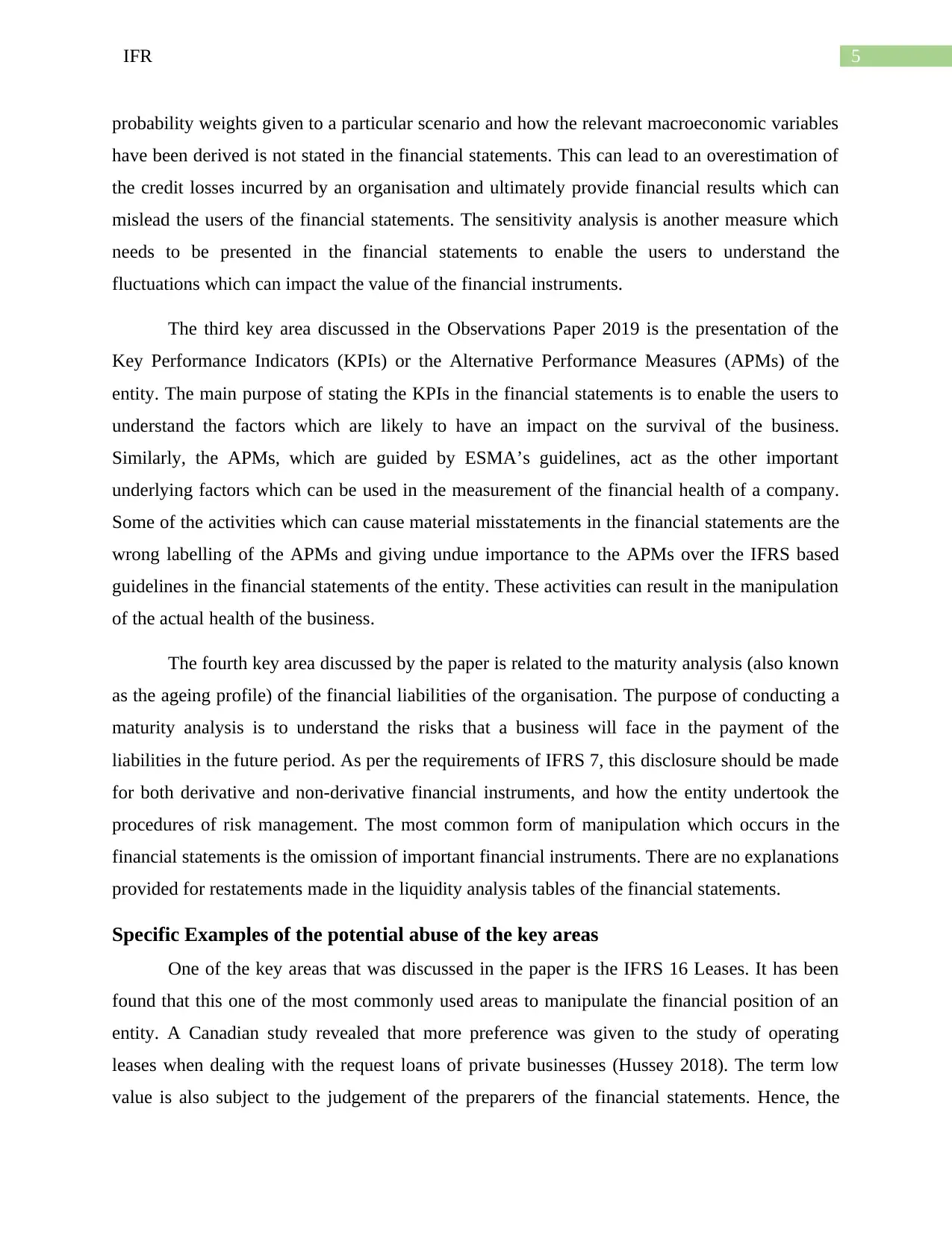
5IFR
probability weights given to a particular scenario and how the relevant macroeconomic variables
have been derived is not stated in the financial statements. This can lead to an overestimation of
the credit losses incurred by an organisation and ultimately provide financial results which can
mislead the users of the financial statements. The sensitivity analysis is another measure which
needs to be presented in the financial statements to enable the users to understand the
fluctuations which can impact the value of the financial instruments.
The third key area discussed in the Observations Paper 2019 is the presentation of the
Key Performance Indicators (KPIs) or the Alternative Performance Measures (APMs) of the
entity. The main purpose of stating the KPIs in the financial statements is to enable the users to
understand the factors which are likely to have an impact on the survival of the business.
Similarly, the APMs, which are guided by ESMA’s guidelines, act as the other important
underlying factors which can be used in the measurement of the financial health of a company.
Some of the activities which can cause material misstatements in the financial statements are the
wrong labelling of the APMs and giving undue importance to the APMs over the IFRS based
guidelines in the financial statements of the entity. These activities can result in the manipulation
of the actual health of the business.
The fourth key area discussed by the paper is related to the maturity analysis (also known
as the ageing profile) of the financial liabilities of the organisation. The purpose of conducting a
maturity analysis is to understand the risks that a business will face in the payment of the
liabilities in the future period. As per the requirements of IFRS 7, this disclosure should be made
for both derivative and non-derivative financial instruments, and how the entity undertook the
procedures of risk management. The most common form of manipulation which occurs in the
financial statements is the omission of important financial instruments. There are no explanations
provided for restatements made in the liquidity analysis tables of the financial statements.
Specific Examples of the potential abuse of the key areas
One of the key areas that was discussed in the paper is the IFRS 16 Leases. It has been
found that this one of the most commonly used areas to manipulate the financial position of an
entity. A Canadian study revealed that more preference was given to the study of operating
leases when dealing with the request loans of private businesses (Hussey 2018). The term low
value is also subject to the judgement of the preparers of the financial statements. Hence, the
probability weights given to a particular scenario and how the relevant macroeconomic variables
have been derived is not stated in the financial statements. This can lead to an overestimation of
the credit losses incurred by an organisation and ultimately provide financial results which can
mislead the users of the financial statements. The sensitivity analysis is another measure which
needs to be presented in the financial statements to enable the users to understand the
fluctuations which can impact the value of the financial instruments.
The third key area discussed in the Observations Paper 2019 is the presentation of the
Key Performance Indicators (KPIs) or the Alternative Performance Measures (APMs) of the
entity. The main purpose of stating the KPIs in the financial statements is to enable the users to
understand the factors which are likely to have an impact on the survival of the business.
Similarly, the APMs, which are guided by ESMA’s guidelines, act as the other important
underlying factors which can be used in the measurement of the financial health of a company.
Some of the activities which can cause material misstatements in the financial statements are the
wrong labelling of the APMs and giving undue importance to the APMs over the IFRS based
guidelines in the financial statements of the entity. These activities can result in the manipulation
of the actual health of the business.
The fourth key area discussed by the paper is related to the maturity analysis (also known
as the ageing profile) of the financial liabilities of the organisation. The purpose of conducting a
maturity analysis is to understand the risks that a business will face in the payment of the
liabilities in the future period. As per the requirements of IFRS 7, this disclosure should be made
for both derivative and non-derivative financial instruments, and how the entity undertook the
procedures of risk management. The most common form of manipulation which occurs in the
financial statements is the omission of important financial instruments. There are no explanations
provided for restatements made in the liquidity analysis tables of the financial statements.
Specific Examples of the potential abuse of the key areas
One of the key areas that was discussed in the paper is the IFRS 16 Leases. It has been
found that this one of the most commonly used areas to manipulate the financial position of an
entity. A Canadian study revealed that more preference was given to the study of operating
leases when dealing with the request loans of private businesses (Hussey 2018). The term low
value is also subject to the judgement of the preparers of the financial statements. Hence, the
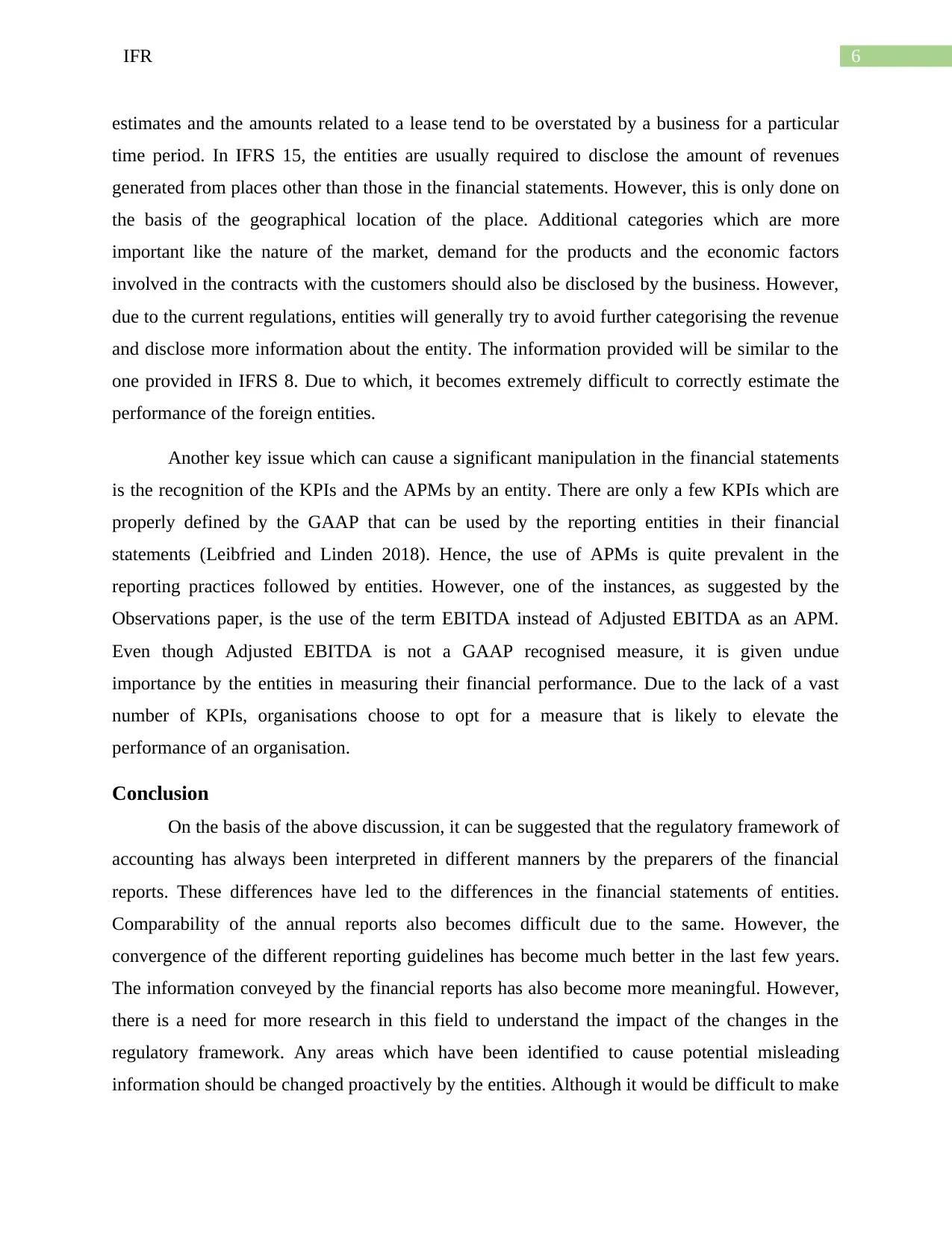
6IFR
estimates and the amounts related to a lease tend to be overstated by a business for a particular
time period. In IFRS 15, the entities are usually required to disclose the amount of revenues
generated from places other than those in the financial statements. However, this is only done on
the basis of the geographical location of the place. Additional categories which are more
important like the nature of the market, demand for the products and the economic factors
involved in the contracts with the customers should also be disclosed by the business. However,
due to the current regulations, entities will generally try to avoid further categorising the revenue
and disclose more information about the entity. The information provided will be similar to the
one provided in IFRS 8. Due to which, it becomes extremely difficult to correctly estimate the
performance of the foreign entities.
Another key issue which can cause a significant manipulation in the financial statements
is the recognition of the KPIs and the APMs by an entity. There are only a few KPIs which are
properly defined by the GAAP that can be used by the reporting entities in their financial
statements (Leibfried and Linden 2018). Hence, the use of APMs is quite prevalent in the
reporting practices followed by entities. However, one of the instances, as suggested by the
Observations paper, is the use of the term EBITDA instead of Adjusted EBITDA as an APM.
Even though Adjusted EBITDA is not a GAAP recognised measure, it is given undue
importance by the entities in measuring their financial performance. Due to the lack of a vast
number of KPIs, organisations choose to opt for a measure that is likely to elevate the
performance of an organisation.
Conclusion
On the basis of the above discussion, it can be suggested that the regulatory framework of
accounting has always been interpreted in different manners by the preparers of the financial
reports. These differences have led to the differences in the financial statements of entities.
Comparability of the annual reports also becomes difficult due to the same. However, the
convergence of the different reporting guidelines has become much better in the last few years.
The information conveyed by the financial reports has also become more meaningful. However,
there is a need for more research in this field to understand the impact of the changes in the
regulatory framework. Any areas which have been identified to cause potential misleading
information should be changed proactively by the entities. Although it would be difficult to make
estimates and the amounts related to a lease tend to be overstated by a business for a particular
time period. In IFRS 15, the entities are usually required to disclose the amount of revenues
generated from places other than those in the financial statements. However, this is only done on
the basis of the geographical location of the place. Additional categories which are more
important like the nature of the market, demand for the products and the economic factors
involved in the contracts with the customers should also be disclosed by the business. However,
due to the current regulations, entities will generally try to avoid further categorising the revenue
and disclose more information about the entity. The information provided will be similar to the
one provided in IFRS 8. Due to which, it becomes extremely difficult to correctly estimate the
performance of the foreign entities.
Another key issue which can cause a significant manipulation in the financial statements
is the recognition of the KPIs and the APMs by an entity. There are only a few KPIs which are
properly defined by the GAAP that can be used by the reporting entities in their financial
statements (Leibfried and Linden 2018). Hence, the use of APMs is quite prevalent in the
reporting practices followed by entities. However, one of the instances, as suggested by the
Observations paper, is the use of the term EBITDA instead of Adjusted EBITDA as an APM.
Even though Adjusted EBITDA is not a GAAP recognised measure, it is given undue
importance by the entities in measuring their financial performance. Due to the lack of a vast
number of KPIs, organisations choose to opt for a measure that is likely to elevate the
performance of an organisation.
Conclusion
On the basis of the above discussion, it can be suggested that the regulatory framework of
accounting has always been interpreted in different manners by the preparers of the financial
reports. These differences have led to the differences in the financial statements of entities.
Comparability of the annual reports also becomes difficult due to the same. However, the
convergence of the different reporting guidelines has become much better in the last few years.
The information conveyed by the financial reports has also become more meaningful. However,
there is a need for more research in this field to understand the impact of the changes in the
regulatory framework. Any areas which have been identified to cause potential misleading
information should be changed proactively by the entities. Although it would be difficult to make
Paraphrase This Document
Need a fresh take? Get an instant paraphrase of this document with our AI Paraphraser
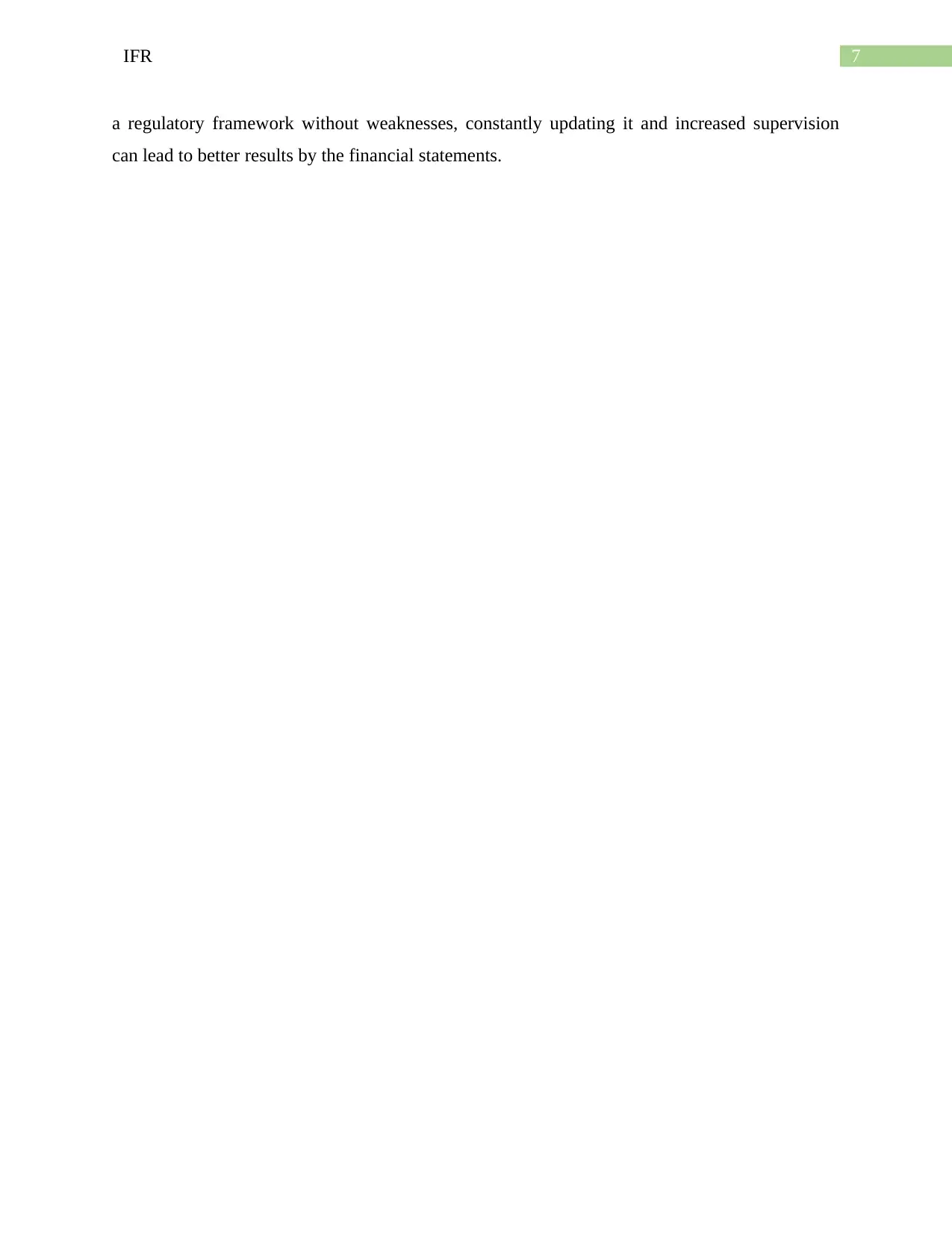
7IFR
a regulatory framework without weaknesses, constantly updating it and increased supervision
can lead to better results by the financial statements.
a regulatory framework without weaknesses, constantly updating it and increased supervision
can lead to better results by the financial statements.
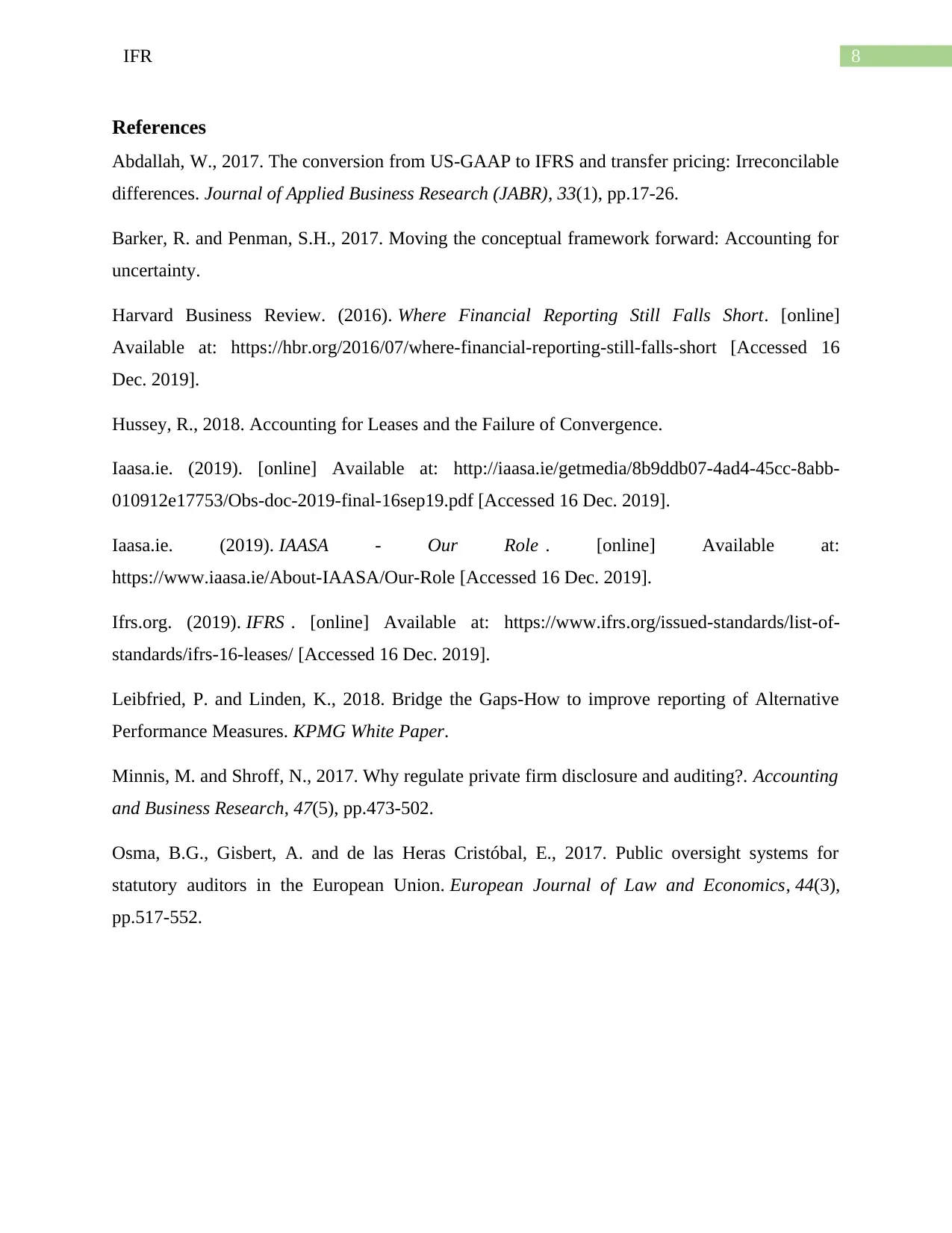
8IFR
References
Abdallah, W., 2017. The conversion from US-GAAP to IFRS and transfer pricing: Irreconcilable
differences. Journal of Applied Business Research (JABR), 33(1), pp.17-26.
Barker, R. and Penman, S.H., 2017. Moving the conceptual framework forward: Accounting for
uncertainty.
Harvard Business Review. (2016). Where Financial Reporting Still Falls Short. [online]
Available at: https://hbr.org/2016/07/where-financial-reporting-still-falls-short [Accessed 16
Dec. 2019].
Hussey, R., 2018. Accounting for Leases and the Failure of Convergence.
Iaasa.ie. (2019). [online] Available at: http://iaasa.ie/getmedia/8b9ddb07-4ad4-45cc-8abb-
010912e17753/Obs-doc-2019-final-16sep19.pdf [Accessed 16 Dec. 2019].
Iaasa.ie. (2019). IAASA - Our Role . [online] Available at:
https://www.iaasa.ie/About-IAASA/Our-Role [Accessed 16 Dec. 2019].
Ifrs.org. (2019). IFRS . [online] Available at: https://www.ifrs.org/issued-standards/list-of-
standards/ifrs-16-leases/ [Accessed 16 Dec. 2019].
Leibfried, P. and Linden, K., 2018. Bridge the Gaps-How to improve reporting of Alternative
Performance Measures. KPMG White Paper.
Minnis, M. and Shroff, N., 2017. Why regulate private firm disclosure and auditing?. Accounting
and Business Research, 47(5), pp.473-502.
Osma, B.G., Gisbert, A. and de las Heras Cristóbal, E., 2017. Public oversight systems for
statutory auditors in the European Union. European Journal of Law and Economics, 44(3),
pp.517-552.
References
Abdallah, W., 2017. The conversion from US-GAAP to IFRS and transfer pricing: Irreconcilable
differences. Journal of Applied Business Research (JABR), 33(1), pp.17-26.
Barker, R. and Penman, S.H., 2017. Moving the conceptual framework forward: Accounting for
uncertainty.
Harvard Business Review. (2016). Where Financial Reporting Still Falls Short. [online]
Available at: https://hbr.org/2016/07/where-financial-reporting-still-falls-short [Accessed 16
Dec. 2019].
Hussey, R., 2018. Accounting for Leases and the Failure of Convergence.
Iaasa.ie. (2019). [online] Available at: http://iaasa.ie/getmedia/8b9ddb07-4ad4-45cc-8abb-
010912e17753/Obs-doc-2019-final-16sep19.pdf [Accessed 16 Dec. 2019].
Iaasa.ie. (2019). IAASA - Our Role . [online] Available at:
https://www.iaasa.ie/About-IAASA/Our-Role [Accessed 16 Dec. 2019].
Ifrs.org. (2019). IFRS . [online] Available at: https://www.ifrs.org/issued-standards/list-of-
standards/ifrs-16-leases/ [Accessed 16 Dec. 2019].
Leibfried, P. and Linden, K., 2018. Bridge the Gaps-How to improve reporting of Alternative
Performance Measures. KPMG White Paper.
Minnis, M. and Shroff, N., 2017. Why regulate private firm disclosure and auditing?. Accounting
and Business Research, 47(5), pp.473-502.
Osma, B.G., Gisbert, A. and de las Heras Cristóbal, E., 2017. Public oversight systems for
statutory auditors in the European Union. European Journal of Law and Economics, 44(3),
pp.517-552.
1 out of 9
Related Documents
Your All-in-One AI-Powered Toolkit for Academic Success.
+13062052269
info@desklib.com
Available 24*7 on WhatsApp / Email
![[object Object]](/_next/static/media/star-bottom.7253800d.svg)
Unlock your academic potential
© 2024 | Zucol Services PVT LTD | All rights reserved.




